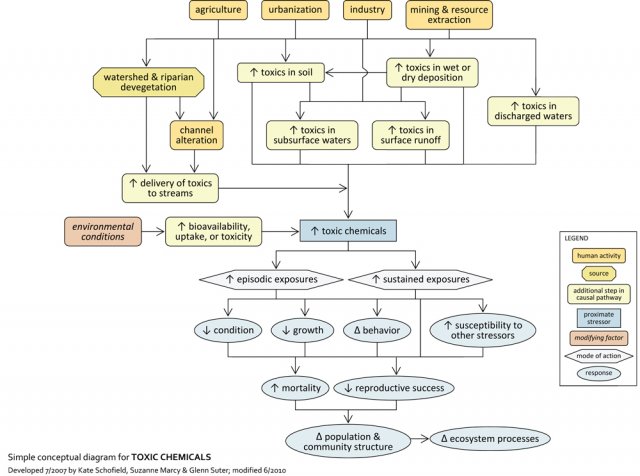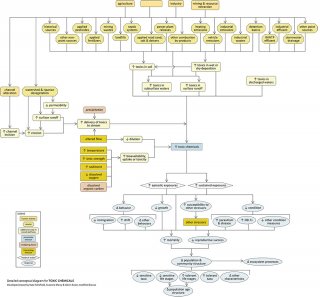Unspecified Toxic Chemicals
Overview
The toxicity of a substance refers to its potential to harm living organisms. Toxicity is a function of exposure concentration and duration, and varies by species, age and condition of exposed organisms. Toxic chemicals, as considered here, are individual chemicals or mixtures of chemicals and their by-products that originate from human activities (Figure 1). These are toxic chemicals that have not yet been identified in the assessment but may be adversely affecting organisms.
These chemicals may be unknown because they have not been measured or measurement is difficult (e.g., due to episodic occurrence, unique chemistry or low concentrations). Their effects may be suspected but, because of absent or incomplete chemical monitoring data, exposure cannot be confirmed. Under these circumstances, "toxic chemicals" should be listed as a candidate cause. Toxic metals, insecticides, and herbicides are considered separately in their own modules.
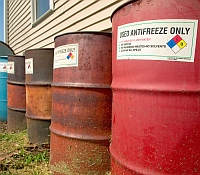
Checklist of Sources, Site Evidence and Biological Effects
Toxic chemicals should be considered a candidate cause when potential human sources and activities, site observations or observed biological effects support portions of the source-to-impairment pathways (Figure 2). This diagram and some of the other information also may be useful in Step 3: Evaluate Data from the Case.
The checklist below will help you identify key data and information useful for determining whether to include unspecified toxics among your candidate causes. The list is intended to guide you in collecting evidence to support, weaken or eliminate toxic compounds as a candidate cause. For more information on specific entries, go to the When to List tab.
Sources and Activities
- Non-point sources from industrial, agricultural, mining, logging, urban and residential activities and related development
- Historical sources and landfills
- Spills and illegal dumping
- Point source discharges from industries, municipal treatment facilities, animal husbandry operations
Site Evidence
- Odors, sheens, discoloration of water
- Deposits on stream banks or bottoms
- Abnormal levels of water quality characteristics such as pH, conductivity, hardness or dissolved oxygen
- Reports of past chemical spills or episodes of toxic releases, such as treatment plant failures
- State, county records of pesticide applications, business operations
Biological Effects
- Abrupt increases in fish or invertebrate mortality
- Other significant community changes, such as large reductions in species richness or abundance
- Abnormal behaviors, such as fish leaping from the water, gasping at the surface, or crowding into tributaries
- Gross pathologies not typical of pathogens, such as tumors, deformities or sloughing of gill tissues
- Appearance of new parasites, disease
- Toxic effects in tests of effluents, ambient waters or sediments
Consider contributing, modifying and related factors as candidate causes when toxic chemicals are selected as a candidate cause. These factors can influence concentration and toxicity, and are important for understanding the dynamics of distribution and effects of toxic chemicals:
- Dissolved oxygen
- Flow alteration
- Ionic strength
- Sediments
- Temperature
- UV exposure
- pH
When to List
- Sources and Activities that Suggest Listing Toxic Chemicals as a Candidate Cause
- Site Evidence that Suggests Listing Toxic Chemicals as a Candidate Cause
- Biological Effects that Suggest Listing Toxic Chemicals as a Candidate Cause
- Site Evidence that Supports Excluding Toxic Chemicals as a Candidate Cause
Sources and Activities that Suggest Listing Toxic Chemicals as a Candidate Cause
Since the industrial revolution, humans have processed, concentrated and released thousands of chemicals to the environment. The enactment of environmental legislation (e.g., Clean Water Act, Clean Air Act) in the 1970s reduced chemical releases. However, toxic chemicals continue to cause impairments in aquatic environments for numerous reasons:
- There are a limited number of water quality criteria supporting regulation, and only a fraction of existing chemicals have established criteria.
- Legacies of contaminated sediments and soils exist from past management practices. These contaminants can become biologically available or mobilized under certain conditions (e.g., oxidation, leaching, flooding events).
- Often substances undergo changes in toxicity, becoming toxic only when transformed or mixed with others in the environment.
- Undocumented pulse events and accidental and illegal releases to surface waters occur.
- There is long range transport of chemicals via water or air.

Photo courtesy of HUD
Useful information on toxic chemicals released to the environment may be found on U.S. EPA websites on the following topics:
Due to the difficulty of conducting effective on-site investigations, the services of specialists in aquatic toxicology and environmental chemistry are often essential for successful evaluations.

Industrial, agricultural, mining, logging, urban and residential activities and related development: These land uses are all potential non-point sources of toxic chemicals. Chemicals in smoke stack emissions can spread widely across the landscape or region (Figure 5). Building materials, solvents, fuels, cleaning materials, drugs and pesticides enter the environment during regular use or operation (e.g., Figure 6).
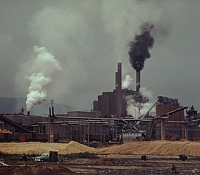
Historical sources and landfills: Past industrial and commercial operations (e.g., tanning operations, slaughterhouses, lumber mills, service stations, dry cleaners) may have contaminated soils and sediments, allowing toxic chemicals to leach into surface waters through surface or subsurface pathways.

Photo courtesy of C.K. Racine
Spills and illegal dumping: Spill events (Figure 7) and dumping can introduce chemicals in concentrated pulses at levels that are acutely toxic to aquatic biota, or result in enduring non-point releases for chronic exposures. Even relatively non-toxic substances, such as sodium sulfate or sodium chloride, can be toxic when present at very high concentrations. When highly toxic substances are involved, the results can be far-reaching and long-lasting. These sources tend to occur in specific locations, like point sources, but are often subsequently distributed in the environment by landscape processes similar to non-point sources, potentially creating lethal episodic exposures.
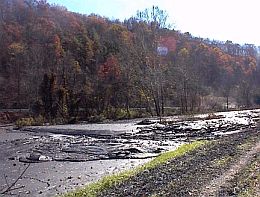
Photo courtesy of S. Webb, University of Kentucky
Enhanced delivery from land uses: Land use changes across the landscape linked to commercial and residential development and other human activities can directly impact delivery of toxic chemicals to surface waters. These factors influence concentration and toxicity, and are important for understanding the dynamics of distribution and effects of toxic chemicals from regular commercial, residential and agricultural activity.
Industries, municipal treatment facilities, commercial establishments and animal husbandry operations: These point sources often discharge mixtures of chemicals directly into surface waters at specific locations (Figure 8). While direct surface water discharges are normally operated under permit, accidental releases, intermittent changes in chemical composition of effluents and/or combined sewer overflow events can contribute to long-term or temporary increases in chemical concentrations.
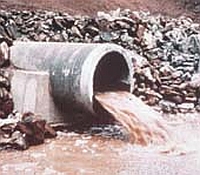
Site Evidence that Suggests Listing Toxic Chemicals as a Candidate Cause
If you observe the following evidence during site reconnaissance, or there are records of past contamination, toxic chemicals should be considered [adapted from Hunn and Schnick (1990)]:
- Odors, sheens or discoloration of the water (Figure 9)
- Sludge or discolored deposits on stream banks or bottoms
- Abnormal levels of water quality characteristics such as pH, conductivity, hardness or dissolved oxygen
- Reports of past chemical spills or episodes of toxic releases, such as treatment plant failures
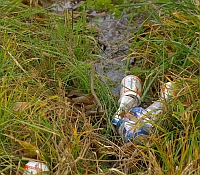
Biological Effects that Suggest Listing Toxic Chemicals as a Candidate Cause
Effects of toxic chemicals on aquatic life can be classified into one of several categories [see Hunn and Schnick (1990)]. Acutely toxic chemicals act quickly and may cause extensive mortality. Some chemicals act generally and kill both plants and animals. Other chemicals act specifically and may affect only plants, only animals or only certain life stages of some kinds of organisms. Mortality or other effects attributable to exposure to these chemicals may be rapid, progressive or lingering, especially if the chemical operates via a chain of adverse environmental changes. Sub-lethal concentrations of toxic chemicals result in more subtle changes. Although these effects are seldom detected in the field, over time they can result in reduced abundances and even local species extirpation and community structure changes.
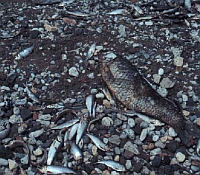
- Abrupt increases in fish or invertebrate mortality (e.g., fish kills, see Figure 10)
- Other significant community changes, such as large reductions in species richness or abundance
- Abnormal behaviors, such as fish leaping from the water, gasping at the surface or crowding into tributaries
- Gross pathologies not typical of pathogens, such as tumors, deformities or sloughing of gill tissues
- Appearance of parasites or diseases, potentially due to toxic stress or immunotoxicity
- Toxic effects in tests of effluents, ambient waters or sediments
Species known to be susceptible or resistant to particular classes of chemicals, by their presence or absence, can signal impact by toxic chemicals. For those chemicals with water quality criteria, more is known about species sensitivities. Clinical signs may also be associated with fish toxicity.
Some examples are listed below, followed by their potential chemical causes in parentheses (U.S. Department of Interior 1970). Note that in some cases, similar biotic effects may be caused by other types of stressors.
- White film on gills, skin or mouth (trinitrophenols)
- Sloughing of gill epithelia (detergents, quinoline)
- Clogged gills (ferric hydroxide)
- Bright red gills (cyanide)
- Dark gills (phenol naphthalene, hydrogen sulfide)
- Hemorrhagic gills (detergents)
- Distended opercles (phenol, cresols, cyanide)
- Blue stomach (molybdenum)
- Pectoral fins in extreme forward position (organophosphates, carbamates)
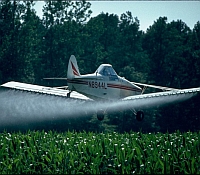
Some types of behaviors suggest exposure to specific chemical classes such as pesticides (Figure 11):
- Organochlorine pesticides cause disorders of the central nervous system that, in fish, can lead to increased ventilation rates, rapid jerky movements of body and fins, uncoordinated movements, spasms, convulsions, racing, increased sensitivity to external stimuli and high excitability. Eventually, fish exposed to organochlorine pesticides may lose equilibrium, and respiration typically stops shortly thereafter (Hunn and Schnick 1990).
- Organophosphorus pesticides cause lethargy and loss of equilibrium in fish. Exposed fish are dark, often showing reddish discoloration with hemorrhaging in muscles and beneath dorsal fins. They become hypersensitive, with startled fish involuntarily swimming in rapid circles. Fish also may have tremors or convulsions and begin coughing. They may display involuntary forward extension of the pectoral fins and opercula, and may exhibit spinal abnormalities. Typically, smaller individuals tend to die first, but eventually all sizes of fish may die (Hunn and Schnick 1990).
Site Evidence that Supports Excluding Toxic Chemicals as a Candidate Cause
There are no site observations that specifically provide evidence of the absence of toxic chemicals. General reasons for excluding a candidate from the list are described in Step 2 of the Step-by-Step guide and in Tips for Listing Candidate Causes.
We strongly caution against using benchmarks of effects (e.g., water quality criteria) as evidence for excluding toxic chemicals from your initial list of candidate causes. Different species have different toxic chemical requirements and different sites have different naturally occurring levels of toxic chemicals.
Ways to Measure
Unknown toxic chemicals, by definition, are either unmeasured or inadequately measured. Thus, this section might be more accurately titled Ways to Identify Unspecified Toxic Chemicals. Aside from direct measurement for specific chemicals in the environment, related measures may be useful in determining if toxic chemicals should be considered as a candidate cause:
- Presence of chemicals in sediments may suggest that they occurred in the water column in the past.
- Presence of chemicals at low concentrations may suggest that they occur at higher concentrations intermittently.
- Presence of by-products or decomposition products are possible indicators of toxic chemicals.
If tests for toxic chemicals have not been analyzed previously, other types of water analyses may suggest the presence of sources of toxic chemicals. For example, elevated ionic strength or biological oxygen demand may suggest the presence (or historical presence) of an effluent or other source.
Conceptual Diagrams
About Conceptual Diagrams
Conceptual diagrams are used to describe hypothesized relationships among sources, stressors and biotic responses within aquatic systems.
Simple Conceptual Model Diagram
Human activities can introduce chemicals to aquatic environments via point and non-point sources. Point sources result in direct discharges of toxics into aquatic systems; examples include industrial or wastewater treatment plants.
Non-point sources (e.g., runoff from agricultural fields) may introduce toxic chemicals to aquatic systems via soil transport, surface runoff, subsurface waters, and atmospheric deposition. Land cover and channel alterations (e.g., land clearing associated construction and development, increased channel incision) also can contribute to toxic contamination, by increasing surface runoff, erosion, and subsequent delivery of contaminants to surface waters.
Stress resulting from one or more toxic chemicals may be due to episodic or sustained increases in chemical concentrations. Episodic exposures can be especially difficult to assess, because measurements must be taken at very specific times to catch these short-term events. However, the distinction between episodic versus sustained increases in toxic chemicals is important, as it may influence the types of biological effects observed.
Additionally, the bioavailability and toxicity of a toxic chemical is influenced to varying degrees by other factors (and/or stressors), including water temperature, pH, hardness, alkalinity, ionic strength, DO, suspended sediment, and dissolved organic matter.
Toxic chemicals, individually or in mixtures, may directly or indirectly impair aquatic plants, invertebrates, and/or fish assemblages. Impairments may include increased mortality, decreased reproduction, behavioral changes, or poor physiological condition, especially in sensitive taxa or life stages; these effects can serve as modes of action for community-based biotic effects.
Decreases in condition can contribute to lower reproductive success, greater susceptibility to other stressors, or increased vulnerability to natural predation and climatic events, further altering population and community structure. Population dynamics may be influenced directly through emigration or through changes in community structure, which subsequently affect food webs and other biotic interactions.
Detailed Conceptual Model Diagram
Although natural biotic and abiotic processes may contribute toxic substances to the environment, these substances are not considered here; toxic effects of metals, ammonia, and pH are discussed in separate modules. This narrative generally follows the diagram from top to bottom, left to right.
Linking Sources to Proximate Stressors
Most human activities result in some release of chemicals into the environment; these releases may introduce toxic chemicals to aquatic systems adsorbed to soil particles, in surface runoff, in subsurface waters, by deposition on water surfaces, or by direct discharge into surface waters. Several potential activities leading to chemical contamination are shown across the top of the diagram, linked to an array of specific sources. Both point and non-point sources may contribute toxic chemicals.
Non-point sources include waste incineration, fossil fuel combustion, fertilizer and pesticide applications, road salting and animal wastes. These activities spread chemicals across the landscape or emit them into the air with later deposition on land and water surfaces. Surface and subsurface transport processes move these chemicals to surface waters. Septic systems, landfills, and industrial and mining wastes pollute surface waters through more localized runoff and leaching processes.
Finally, point source discharges (e.g., end of a pipe discharges) include industrial effluents, wastewater treatment plant effluents, stormwater overflows, and other sources that can deliver chemicals directly into surface waters. Point sources are normally, but not always, discharged under permit. This array of potential sources suggests that any single body of water can be contaminated by many sources, and thus exposed to a mixture of chemicals – some of which may be causing observed effects.
Historical sources are sources that are no longer active. Past deposition of contaminants onto soil, leachates from poorly designed landfills, buried toxic wastes from commercial or military operations, former spills, illegally disposed wastes, or past contamination released from any of the other potential sources may continue to leach toxic chemicals into surface waters through surface or subsurface transport. Many of these sites have been obscured by time, natural vegetative growth, and lost or destroyed records, so their discovery may only occur because of observed biotic effects.
A number of important processes can modify the delivery and toxicity of chemicals released to the environment, although they are not actually sources of chemicals themselves. Channel alteration can lead to channel incision and erosion that may deliver contaminated sediments to streams, creating episodic events. Loss of natural land cover along riparian zones and across the watershed, as well as hardening of land surfaces, enhance delivery of chemicals to water bodies through surface and subsurface transport processes.
Delivery of chemicals to surface waters also is influenced by precipitation patterns, a contributing environmental condition (hexagon). Precipitation events may wash toxic chemicals into surface waters; decreased precipitation, as well as water removal for human use, can decrease dilution and increase concentrations of existing chemicals. Dissolved organic carbon also may influence bioavailability and uptake of contaminants.
The toxicity of chemicals can be enhanced or diminished by other stressors, including increased ionic strength and suspended sediments, decreased dissolved oxygen, or changes in temperature. Changes in these additional stressors can alter the impact of chemical toxicity, and may also interact with transport and exposure modifying factors noted above.
Linking Proximate Stressors to Biological Impairment
The proximate stressor in this model is “toxic chemicals” in surface waters (center blue box). Both episodic and sustained exposures to toxic chemicals can lead to the array of effects shown. High concentrations of a toxic chemical delivered in episodic runoff events, effluents released during treatment failures, spills, or other such events may lead to acute toxicity and death of some or all biota.
Continuous point sources, atmospheric deposition, contaminated groundwater or other sustained sources may cause impairment through chronic toxic effects of low level concentrations (see hexagons, center). It is likely that different chemicals will be delivered to a water body through multiple transport mechanisms.
Clues as to the nature of the chemical and how exposure is occurring may be found in processes (hexagons) that lead to alteration of biotic communities. Emigration from, or avoidance of immigration to, areas within a water body may suggest localized concentrations. Abrupt mortality may suggest acute toxicity; acute exposures often also cause injuries and increase susceptibility to other stressors.
Episodic exposures may cause gill injuries that increase susceptibility to pathogens. Sustained exposures may lead to injuries and deformities, increased parasitism and disease, and a general increase in sensitivity to other stressors. Lowered reproductive success may suggest sustained exposure. Further evidence may be found in evaluating the presence or absence of sensitive taxa or life stages, and changes in population age structure. In some cases loss of one species will influence community structure (e.g., because a critical food source is lost).
Toxic effects depend on numerous factors, including characteristics of the chemical; species, age and condition of the biota; characteristics of the surface water; exposure pathway; amount and mode of delivery; and environmental concentrations of the chemicals. Chemical toxicity can lead to biologically impaired plant, invertebrate and/or fish assemblages. When chemical toxicity is suspected, further investigation is needed to determine which chemical or mixture of chemicals may be the cause of impairment.
Literature Reviews
A causal analysis of toxic chemicals may benefit from information concerning the characteristic effects of commonly occurring toxic chemicals and the concentrations at which they occur, even if there is uncertainty about the identity of the specific chemicals involved. U.S. EPA's ambient water quality criteria documents provide access to high quality data and narrative summaries for many chemicals that have caused adverse effects on aquatic life.
Since the early 1980s, U.S. EPA has been developing ambient water quality criteria designed to protect aquatic organisms from harmful exposure to chemicals. These water quality criteria documents are valuable sources of exposure-response information for aquatic organisms, and each contains a comprehensive review of the aquatic toxicity literature for that particular chemical at the time of publication.
The aquatic toxicity data used to derive the criteria are screened to ensure they meet certain toxicity test practices and data quality objectives. More information on how data are screened can be found in U.S. EPA (1991). Finally, the toxicity data contained in the criteria documents are arrayed from least sensitive to most sensitive, which is useful for comparing the effects on species in the field to relative sensitivities in the laboratory. Additional attributes of these documents include:
- Acute and chronic toxicity data conforming to standard test durations and endpoints in separate tables for freshwater and saltwater animals. Acute toxicity data usually reflect severe endpoints from short-term exposures (e.g., 2- to 4-day LC50s or EC50s). Chronic toxicity data usually reflect exposure over all or part of an organism's life cycle and include sublethal (e.g., growth, reproduction, development) and lethal (survival) endpoints.
- Data on chemical toxicity to aquatic plants (algae, macrophytes) and on bioaccumulation in aquatic organisms.
- Discussions of the environmental chemistry of the chemical, speciation, best measures of the chemical in water and relative species sensitivities.
Since most of the toxicity data contained in the criteria documents reflects exposures to a single chemical under standardized conditions in the laboratory, caution should be exercised when comparing such data to effects on organisms in the field, because other factors may increase or decrease a chemical's toxicity in the natural environment. Older criteria documents should be supplemented by more recent publications.
References
- Hunn JB, Schnick RA (1990) Toxic substances. in: Meyer FP, Barclay LA (Eds). Field Manual for the Investigation of Fish Kills. U.S. Fish and Wildlife Service, Washington DC. Resource Publication 177.
- Stewart AJ (2001) A simple stream monitoring technique based on measurements of semiconservative properties of water. Environmental Management 27(1):37-46.
- U.S. Department of the Interior (1970) Investigating Fish Mortalities. Division of Technical Support, Federal Water Pollution Control Administration, Washington DC. CWT-5. 21 pp.
- U.S. EPA (1991) Technical Support Document for Water Quality-Based Toxics Control. U.S. Environmental Protection Agency, Office of Water, Washington DC. EPA/505/2-90-001.
Contacts: Authors & Contributors

